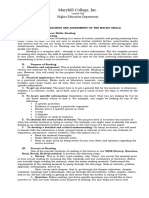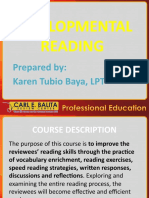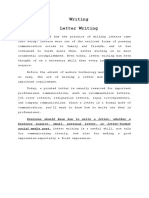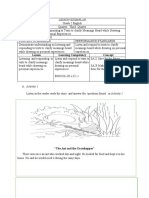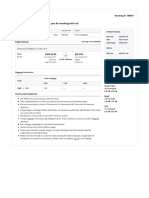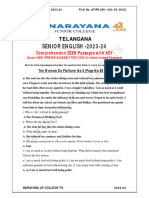Comprehension, or Extracting Meaning From What You Read
Comprehension, or Extracting Meaning From What You Read
Uploaded by
TJ WAQUIMCopyright:
Available Formats
Comprehension, or Extracting Meaning From What You Read
Comprehension, or Extracting Meaning From What You Read
Uploaded by
TJ WAQUIMOriginal Title
Copyright
Available Formats
Share this document
Did you find this document useful?
Is this content inappropriate?
Copyright:
Available Formats
Comprehension, or Extracting Meaning From What You Read
Comprehension, or Extracting Meaning From What You Read
Uploaded by
TJ WAQUIMCopyright:
Available Formats
Comprehension, or extracting meaning from what
you read, is the ultimate goal of reading. Experienced
readers take this for granted and may not appreciate the
reading comprehension skills required. The process of
comprehension is both interactive and strategic. Rather than
passively reading text, readers must analyze it, internalize
it and make it their own.
Comprehension refers to the ability to understand written
words. It is different from the ability to recognize words.
Recognizing words on a page but not knowing what they mean
does not fulfill the purpose or goal of reading, which is
comprehension. Imagine, for example, that a teacher gives a
child a passage to read. The child can read the entire
passage, but he or she knows nothing when asked to explain
what was read. Comprehension adds meaning to what is read.
Reading comprehension occurs when words on a page are not just
mere words but thoughts and ideas. Comprehension makes reading
enjoyable, fun, and informative. It is needed to succeed in
school, work, and life in general.
Reading comprehension is the ability to process text,
understand its meaning, and to integrate with what the reader
already knows.
Fundamental skills required in efficient reading
comprehension are knowing meaning of words, ability to
understand meaning of a word from discourse context, ability
to follow organization of passage and to identify antecedents
and references in it, ability to draw inferences from a
passage about its contents, ability to identify the main
thought of a passage, ability to answer questions answered in
a passage, ability to recognize the literary devices or
propositional structures used in a passage and determine its
tone.
Some people think of the act of reading as a
straightforward task that’s easy to master. In reality,
reading is a complex process that draws on many different
skills. Together, these skills lead to the ultimate goal of
reading: reading comprehension, or understanding what’s been
read.
Reading comprehension can be challenging for lots of
reasons. Whatever the cause, knowing the skills involved, and
which ones your child struggles with, can help you get the
right support.
In order to read with comprehension, developing readers
must be able to read with some proficiency and then receive
explicit instruction in reading comprehension strategies.
The process of comprehending text begins before
children can read, when someone reads a picture book to them.
They listen to the words, see the pictures in the book, and
may start to associate the words on the page with the words
they are hearing and the ideas they represent.
In order to learn comprehension strategies,
students need modeling, practice, and feedback.
Case Study C
Jorge and Angela had the same reading problems in second
year high school. Both were fourteen years old. They had
normal IQ as shown in the intelligence test given by the
guidance counselor.
Both of them were shy and slow readers. Their voices
could hardly be heard whenever they recite or answer
questions. Interviews revealed that they had poor study
habits. They had low scores in comprehension of main ideas,
noting details, seeing cause-and-effect relationships, and in
note taking, summarizing, and organizational skills.
In the Informal Reading Test, Jorge and Angela obtained
reading levels of 4.5 and 4.7, respectively, when they should
have a reading performance of at least 6.5 in order to cope
with academic work in sophomore high school.
Remember:
The information you gain from reading is important. If
you just “do it,” without learning something, you’re wasting a
lot of your time. Train your mind to learn while reading with
SQ3R.
A. SQ3R/PQ3R
Two reading formulas which are similar and which are very
effective are the SQ3R and the PQ3R. S stands for Survey,
while P means Prepare.
SQRRR or SQ3R is a reading comprehension method named for
its five steps:
survey, question, read, recite and review.
-The method was introduced by Francis P. Robinson, an
American education philosopher in his 1946 book Effective
Study.
According to Irwin L. Joffe, the PQ3R technique helps the
reader study textbook chapters with better understanding and a
better recollection of the information given.
SQ3R is a comprehension strategy that helps students
think about the text they are reading while they’re reading.
Often categorized as a study strategy, SQ3R helps students
“get it” the first time they read a text by teaching students
how to read and think like an effective reader.
This useful strategy aids reading comprehension and is
especially helpful for difficult textbook material. Each part
of the process is helpful by itself, so do not feel that you
must follow all of the steps.
This strategy includes the following five steps:
Survey:
Before you begin a new chapter, skim the material and get
a feel for the main topics and ideas in the text. The process
below should take 5-10 minutes.
Students review the text to gain initial meaning from the
headings, bolded text, and charts.
-Gather the information necessary to focus and formulate
goals
Read the introduction
Help your mind prepare to receive the subject at hand.
Look at the headings and subheadings
Look at the pictures, charts and graphs (anything visual)
Read the chapter summary
Look at the study questions at the end of the chapter
In other words, skim the text, but do so with
the purpose of getting a sense of the focus and
general ideas presented in the reading.
Question:
Students begin to generate questions about their reading
from previewing it.
-Use questions to guide your reading.
Help your mind engage and concentrate
Turn the boldface heading for each section into as many
questions as you think will be answered in that section.
The better the questions, the better your comprehension
is likely to be. You may always add further questions as
you proceed. When your mind is actively searching for
answers to questions it becomes engaged in learning.
Generate questions about the content of the reading. For
example, convert headings and sub-headings into questions, and
then look for answers in the content of the text. Other more
general questions may also be formulated:
What is this chapter about?
What question is this chapter trying to answer?
How does this information help me?
Take the first heading in the chapter and turn it into a
question before reading the paragraphs in that section.
For instance, if the heading is “A Limited Partnership”,
read it as “What is a limited partnership?” Now you have
created a purpose for reading because you are looking for
the answer to the question.
If you know what you’re looking for, you can
spot the information as you read.
Read:
As students read, they need to look for answers to the
questions they formulated during their preview of the text.
These questions, based on the structure of the text, help
focus students’ reading.
-Fill in the information around the mental structures
you’ve been building
Read one section at a time with your questions in mind
and look for the answers. Recognize when you need to make up
some new questions.
As you read look for answers to the questions you created. Use
the following tips when reading:
I. Usually the first sentence of each paragraph states the
main idea.
II. Look for transition words such as next, for example, in
contrast, in addition, to help you follow the author’s
point.
III. Make notes in the margin or in a notebook as you read.
Paraphrase main points and ideas; do NOT simply copy
information from the textbook.
IV. Highlight only the most important points. Too much
highlighting can make it difficult to separate the main
point from support details
This one is pretty self-explanatory, but remember,
you’re not just reading the words to read them.
You’re reading with a purpose in mind. You’re
actively seeking information.
As you read, don’t forget to take notes on key
content to help you not only understand the text more
effectively but also help find information when
studying or citing information in a paper.
Recite:
When the students have finished reading the
material, the next step in SQ3R that they have
to do is recite. In this step, students have to
recite the main points of the text with the
book closed.
As students move through the text they should recite or
rehearse the answers to their questions and make notes about
their answer for later studying.
-After reading, look at the questions you created or
those at the end of the chapter.
-The reader should try to recite from memory what was
learned in the same manner as telling someone else about the
information. It is important that the reader use their own
words in order to formulate and conceptualize the material.
Try recalling and identifying major points
(heading/subheadings)
Can you answer them? If you cannot, go back, reread the
appropriate Sections, and take notes.
-Take the time and recite or recall whatever you can
Remember as soon as you finish reading.
Retrain your mind to concentrate and learn as it reads
-After each section, stop and recall your questions and
see if you can answer them from memory. If not, look back at
the text again (as often as necessary), but don’t move to the
next section until you can recite the answers from the
previous one.
Review:
After reading, students should review the text to answer
lingering questions and recite the questions they previously
answered.
-The last step in using SQ3R as reading technique is
review. When the students finished reading the text, go back
through it section by section to see if they can still
remember the important material
-After you study new material, it is extremely important
to conduct an overall review within 24 hours for maximum
comprehension and memory.
-The final “R” is “Review.” Once you reach the end of the
passage, review the material by repeating back to yourself
what the point of the passage is using your own words. You may
then repeat the process on the second set of questions.
-Refine your mental organization and begin building memory
Once you’ve finished the entire chapter using the
preceding steps, go back over the questions you create for
every heading. See if you can still answer them. If not, look
back and refresh your memory and then continue.
You can lose 80% of what you have learned if you do not review
within the next day.
To conclude, in this step, students are asked to review the
whole text guided by the teacher to see if they can still
remember the main points of the text.
Create and use the strategy
As with its sister strategy Question-Answer Relationship
(QAR), SQ3R requires the teacher to model.
Explain to students that effective readers do many things
while reading, including surveying, questioning, reading,
reciting and reviewing.
Choose a content area passage to read and model the five
SQ3R steps.
During each step, make sure to explain what you’re doing
and why you’re doing it.
After your modeling session, invite students to
independently read a selection and practice applying the
SQ3R steps. This could be completed as an in-class or
take-home assignment.
Afterwards ask students to review their notes and reflect
on the process. Were they surprised by how much they
remember by using the SQ3R method?
Students may not be “sold” on this strategy the first
time they try it. Not all readings will be worth the time
it takes to complete the SQ3R steps, so help students to
understand not just how to apply it, but when to apply
it.
PQR METHOD
PQR:
PQ3R is an acronym for Preview, Questions, Read,
Recite, and Review.
PQ3R is a streamlined study method that aids the
learner in subject matter mastery, and facilitates
generalization of new-knowledge-gained into real-
world settings. PQ3R
To use this strategy, follow these steps:
Prepare:
Before you begin to read, prepare your reading.
Look at how long the text is. Make note of images and
lists. Think about how a section or text is
organized.
Is all about understanding the big picture of
what the chapter will be covering before diving into
detailed pages. Garner big picture information by
reading in the following order; chapter title,
introduction, subheadings, and the first sentence of
each paragraph. Take time to peruse illustrations.
Finally, read the chapter summary.
QUESTION:
Turn subtitles into questions. Think about the
probable content of the subsections.
Develop questions:
Ask yourself, “What are the key concepts and terms
in this section? What do I already know about this
topic? How do these concepts relate to previous
sections in the text or to the topics I have already
studied?”
As the reader previews the text chapter, she
should be aware of questions generated by major topic
sections and subheadings. Record these questions, and
keep them in mind when engaging in the next step, a
thorough reading of the chapter. A list of custom-
created questions helps the reader to become an
active participant in the learning process.
Read:
Read to find the answers to the questions you asked.
-Now read the entire chapter. Previewing and
question-gathering should help the reader to find the
detailed information more meaningful and easier to
understand. Pay attention to any highlighted or bold
type in the text. Invest time in taking a second look
at all graphs, charts and illustrations and reading
their captions. Reread any sections that are at first
uunclear
As you read, keep the questions you have generated in
mind and think about your answers.
RECITE:
Look away and tell yourself, from memory, what you
read.
Answer the questions recorded after previewing
the chapter. The reader’s self-check of personal
understanding and absorption of the information
presented in the chapter is revealed in her ability
to correctly and clearly answer not only the
questions generated by the preview of the chapter,
but in any formal chapter review questions, as
provided in the body of the text.
REVIEW:
Look at each subtitle. Tell yourself what the
subsection is all about.
Review: Once you have responded to your reading,
review what you have written and return to the text
to see what details you have forgotten or
misrepresented. Read those sections and try to write
again.
-A day or two after completing the steps,
the reader should try a self-test; can she clearly
summarize the major points of the chapter? Can she
answer both the personally generated questions and
the chapter questions with relative ease? Does the
reader feel confident that she could discuss chapter
content with an instructor or other student and prove
understanding? Yes, yes and yes? Then PQ3R has
worked.
This strategy works better—and is actually less time-
consuming— than re-reading your text. The writing
that you produce can become a record of your studying
to which you can return.
CONCLUSION:
Textbooks are jam-packed with information. Each page
seems to be chock full of pictures, charts, and sidebars. And
then there’s the text! Some words are in color, others in
italics or bold print, not to mention large chunks of plain
text. Surely every little detail on the page doesn’t need to
be memorized, does it?
Strategically approaching textbook assignments can help a
reader not only move through his reading more efficiently but
it can also make him a more effective reader and learner. One
strategy that has been proven to help readers comprehend and
think about texts is SQ3R.
SQ3R is five-step technique that you can use to learn
more effectively, and to increase your retention of written
information. It helps you to focus what you need from a
document, and to create a clear structure for the information
in your mind.
Using SQ3R reading comprehension strategy accomplished
reading activities better than those who did not. This
strategy equips students for more systematic and structured
reading techniques, so they comprehend the text in a better
way. It makes students active and co-operative.
Reading is a very important skill to master. Whether we
realize it or not we read quite a bit every day. We read the
directions on food items, we read the TV guide, and we read
text messages on our cell phones, to name a few instances of
daily reading. The SQ3R method is a way to practice fully
immersing oneself into reading an article or book. The S
represents survey. The Q represents question. The 3R
represents read, recite, and review. We are going to practice
this method while reading an article of your choosing.
SQ3R is five-step technique that you can use to learn
more effectively, and to increase your retention of written
information. It helps you to focus what you need from a
document, and to create a clear structure for the information
in your mind.
You might also like
- When Kids Can't ReadDocument67 pagesWhen Kids Can't ReadjmelvinuabNo ratings yet
- Collectors Investments: South Africa Coin ListDocument5 pagesCollectors Investments: South Africa Coin ListbelebelNo ratings yet
- MCWP+3 01+Offensive+and+Defensive+TacticsDocument434 pagesMCWP+3 01+Offensive+and+Defensive+TacticsElkin Villalobos100% (1)
- 7 Critical Reading StrategiesDocument6 pages7 Critical Reading StrategiesIlyana Hani67% (3)
- School-Based Inset 2020Document47 pagesSchool-Based Inset 2020Mhilgene Briones Manalo100% (4)
- Language Use CompleteDocument73 pagesLanguage Use CompletePurity KangogoNo ratings yet
- Module 5Document31 pagesModule 5cecilia bondadNo ratings yet
- RNW Reviewer MidtermsDocument21 pagesRNW Reviewer Midtermsdon16.joseNo ratings yet
- English MergedDocument157 pagesEnglish MergedMehvish ZaibNo ratings yet
- Reflective Reading Concept Components and FactorsDocument5 pagesReflective Reading Concept Components and FactorsVeena Rani100% (3)
- CHAPTER 2-Reading Techniques - MODDocument17 pagesCHAPTER 2-Reading Techniques - MODKrys AngelaNo ratings yet
- Reading 1. Strategies For Inferential Reading.: Question and Answer StrategiesDocument4 pagesReading 1. Strategies For Inferential Reading.: Question and Answer StrategiesJose ParedesNo ratings yet
- Teaching ReadingDocument34 pagesTeaching ReadingАрайлым ЕлеусізоваNo ratings yet
- Topic 3Document11 pagesTopic 3Wan Amir Iskandar IsmadiNo ratings yet
- Introductio N: A Practical Guide For ReadingDocument44 pagesIntroductio N: A Practical Guide For ReadingJoshNo ratings yet
- Castro, Cristina P. Assignment No.9 Beed Iii-1 Teaching English in The Elementary Grade Review QuestionsDocument2 pagesCastro, Cristina P. Assignment No.9 Beed Iii-1 Teaching English in The Elementary Grade Review QuestionsCristina CastroNo ratings yet
- OLENG - Chapter 2Document11 pagesOLENG - Chapter 2jessabongbongNo ratings yet
- Reading Skill and Effective ReadingDocument7 pagesReading Skill and Effective ReadinghasssbolNo ratings yet
- Unit 1 and 2 CE-OCTDocument49 pagesUnit 1 and 2 CE-OCTmerp7gt650twinNo ratings yet
- Lecture 1Document11 pagesLecture 1bhaichuzaNo ratings yet
- Teaching & Assessment of The Macro SkillsDocument7 pagesTeaching & Assessment of The Macro SkillsKrystel Mary SungaNo ratings yet
- Reading SkillsDocument11 pagesReading SkillsAqsa ZahidNo ratings yet
- Detailed Notes On SkimmingDocument6 pagesDetailed Notes On SkimmingTayyaba AkramNo ratings yet
- HO3. Week 4Document2 pagesHO3. Week 4Cgc Bryan Del PilarNo ratings yet
- UNIT 3 Reading Techniques & Note Making TechniquesDocument10 pagesUNIT 3 Reading Techniques & Note Making TechniquesUtpal KantNo ratings yet
- Teaching Reading Theory 20 Copies PDFDocument7 pagesTeaching Reading Theory 20 Copies PDFDN MukhiyaNo ratings yet
- Activity 2: Read The Text Below and Complete The Table That FollowsDocument3 pagesActivity 2: Read The Text Below and Complete The Table That Followsraymondmadelo01No ratings yet
- What Research Tells Us About ReadingDocument3 pagesWhat Research Tells Us About ReadingDemona ValentineNo ratings yet
- English 111Document1 pageEnglish 111Jonathan Delos SantosNo ratings yet
- Teaching Reading in High SchoolDocument37 pagesTeaching Reading in High SchoolLanie Abaja Florendo100% (1)
- Module IDocument13 pagesModule IKharxz Hanz Christian GalendezNo ratings yet
- Assigment On Special English: Submitted by (19BDEN01) A.Agnes PreethaDocument6 pagesAssigment On Special English: Submitted by (19BDEN01) A.Agnes PreethaAntoNo ratings yet
- ReadingDocument4 pagesReadingcharmaine aurinNo ratings yet
- Effective ReadingDocument12 pagesEffective ReadingAryan AhmedNo ratings yet
- Effective ReadingDocument12 pagesEffective ReadingAryan AhmedNo ratings yet
- Academic Reading and Writing NotesDocument60 pagesAcademic Reading and Writing NotesEljhon Steve SatsatNo ratings yet
- Orca Share Media1570154169305Document4 pagesOrca Share Media1570154169305Aisalie F. BoloNo ratings yet
- READING STYLESDocument24 pagesREADING STYLESHazel KrinezzaNo ratings yet
- Cognitive Process Symbols Language Acquisition Information: Reading Is A Complex "Document6 pagesCognitive Process Symbols Language Acquisition Information: Reading Is A Complex "Luv SharmaNo ratings yet
- Reading ComprehensionDocument10 pagesReading ComprehensionNishtha MakwanaNo ratings yet
- Academic Writing Notes 1Document108 pagesAcademic Writing Notes 1Eman KhurramNo ratings yet
- While-Reading AvtivitiesDocument2 pagesWhile-Reading AvtivitiesCarmen DulgheruNo ratings yet
- Critical Reading TipsDocument21 pagesCritical Reading TipsJan Dave JimenezNo ratings yet
- What Is Reading Comprehension?: Module 3 Lesson 3 Comprehension: The Ultimate Goal of ReadingDocument19 pagesWhat Is Reading Comprehension?: Module 3 Lesson 3 Comprehension: The Ultimate Goal of Readingjoy pamorNo ratings yet
- E-Content - Art of ReadingDocument6 pagesE-Content - Art of ReadingRICHA School of Business and ManagementNo ratings yet
- READINGDocument22 pagesREADINGdellaishere03No ratings yet
- 2 Reading MaterialDocument17 pages2 Reading MaterialRicky FegianNo ratings yet
- 7 Critical Reading StrategiesDocument17 pages7 Critical Reading StrategiesGemmalyn MatucolNo ratings yet
- Exam MTBDocument6 pagesExam MTBRamon III ObligadoNo ratings yet
- Welcome To English II Reading Comprehension by Maru Mary Jones Panjaitan S.Pd.,M.A.EdDocument16 pagesWelcome To English II Reading Comprehension by Maru Mary Jones Panjaitan S.Pd.,M.A.EdWill AsinNo ratings yet
- Good and Poor ReadersDocument2 pagesGood and Poor ReadersTJ WAQUIMNo ratings yet
- Teaching Reading StrategiesDocument4 pagesTeaching Reading StrategiesThomas Herrera GómezNo ratings yet
- 3 R Eceptive Skills: Reading: How Can You Help Your Students Improve Their Reading?Document5 pages3 R Eceptive Skills: Reading: How Can You Help Your Students Improve Their Reading?Anita MadunovicNo ratings yet
- Module English For ACADDocument14 pagesModule English For ACADnancy floresNo ratings yet
- 1.reading Comprehension Is The Level of Understanding of A Text/message. This UnderstandingDocument9 pages1.reading Comprehension Is The Level of Understanding of A Text/message. This UnderstandingAirlia Lou CorpinNo ratings yet
- Developmental Reading Final LectureDocument141 pagesDevelopmental Reading Final LectureDavid-Aragorn Peredo TelmoNo ratings yet
- Reading Process Stages of Reading: Pre-Reading Before Readaing During Reading After ReadingDocument4 pagesReading Process Stages of Reading: Pre-Reading Before Readaing During Reading After ReadingAbegail LaurenteNo ratings yet
- Reading Skills For ComprehensionDocument46 pagesReading Skills For Comprehensionnamma.wedding1806No ratings yet
- Jiptummpp GDL Junaidin20 47994 3 Chapter IDocument15 pagesJiptummpp GDL Junaidin20 47994 3 Chapter IJulia nurul AkmalNo ratings yet
- Soft Skills - Notes - Unit - 3Document43 pagesSoft Skills - Notes - Unit - 3Dulce DeNo ratings yet
- Hello PoDocument5 pagesHello PoRemy LuntauaonNo ratings yet
- Materials For Teaching Grammar - WorksheetDocument42 pagesMaterials For Teaching Grammar - WorksheetTJ WAQUIMNo ratings yet
- Cognate ReportDocument29 pagesCognate ReportTJ WAQUIM0% (1)
- Revising As A Writing Process - Joela CastilDocument19 pagesRevising As A Writing Process - Joela CastilTJ WAQUIMNo ratings yet
- Good and Poor ReadersDocument2 pagesGood and Poor ReadersTJ WAQUIMNo ratings yet
- Writing Fiction: Play WritingDocument33 pagesWriting Fiction: Play WritingTJ WAQUIMNo ratings yet
- Lesson Learning Competency ConceptDocument4 pagesLesson Learning Competency ConceptTJ WAQUIMNo ratings yet
- Creative Letter WritingDocument21 pagesCreative Letter WritingTJ WAQUIMNo ratings yet
- Some Examples of English Words Borrowed From Foreign LangaugesDocument2 pagesSome Examples of English Words Borrowed From Foreign LangaugesKinley WangchukNo ratings yet
- Inquiry Based LearningDocument14 pagesInquiry Based LearningAriel NubeNo ratings yet
- Dear Ahmad Sagheer, Ticket is Con韌�rmed. Thank you for booking with us!Document1 pageDear Ahmad Sagheer, Ticket is Con韌�rmed. Thank you for booking with us!Inam ZahoorNo ratings yet
- Quatation of Incorporation Fees For Incorporate LLP-10,000 Fees For Incorporate Pvt. LTD - 12,000 Fees For Incorporate NGO - 20,000Document3 pagesQuatation of Incorporation Fees For Incorporate LLP-10,000 Fees For Incorporate Pvt. LTD - 12,000 Fees For Incorporate NGO - 20,000Manish JainNo ratings yet
- ASE20098 January 2020 Mark SchemeDocument13 pagesASE20098 January 2020 Mark SchemeTi SodiumNo ratings yet
- SKODA ASN-ig enDocument14 pagesSKODA ASN-ig enqingpingleNo ratings yet
- City Identity EssayDocument8 pagesCity Identity EssayCut Rini Nabila PutriNo ratings yet
- Perubahan Sosial Masyarakat Nelayan Di Desa Cupel Kecamatan Negara Kabupaten JembranaDocument12 pagesPerubahan Sosial Masyarakat Nelayan Di Desa Cupel Kecamatan Negara Kabupaten Jembrana36Muhammad Rizal AfnaniNo ratings yet
- Sas #10 - Edu 537 PDFDocument7 pagesSas #10 - Edu 537 PDFDivine Joy Atractivo PinedaNo ratings yet
- Sekolah Menengah Kebangsaan Sungai Layar, 08000 SG Petani, KedahDocument4 pagesSekolah Menengah Kebangsaan Sungai Layar, 08000 SG Petani, KedahAsoda VaNo ratings yet
- Learning Plan: Analogy To Show Relationships of WordsDocument2 pagesLearning Plan: Analogy To Show Relationships of WordsMonaliza PawilanNo ratings yet
- Infosys Campus Recruitment ProgramDocument7 pagesInfosys Campus Recruitment ProgramNANDA KISHORNo ratings yet
- SR Eng Added Seen Passgaes With Key (Telangana)Document7 pagesSR Eng Added Seen Passgaes With Key (Telangana)medigachaithu9No ratings yet
- CPE 310 - Method of ResearchDocument17 pagesCPE 310 - Method of ResearchRomano GabrilloNo ratings yet
- Scriptures For Studying and ExamsDocument3 pagesScriptures For Studying and Examsvimon100% (1)
- Who Good Faith-Good Faith Good Faith-Bad Faith Bad Faith-Good FaithDocument1 pageWho Good Faith-Good Faith Good Faith-Bad Faith Bad Faith-Good FaithJohn Marti MaghopoyNo ratings yet
- Chapter 2 Managing Global EnvironmentDocument32 pagesChapter 2 Managing Global EnvironmentNill ProjapotiNo ratings yet
- Freedom: Neville Goddard and MR Twenty TwentyDocument52 pagesFreedom: Neville Goddard and MR Twenty TwentyClaudemir100% (2)
- OUTLINE LAND TITLE AND DEEDS Revised 2Document2 pagesOUTLINE LAND TITLE AND DEEDS Revised 2Zebulun DocallasNo ratings yet
- Juvenile Delinquency SourcesDocument93 pagesJuvenile Delinquency SourcesAubrey Marie VillamorNo ratings yet
- Rhythmic Counting SyllablesDocument2 pagesRhythmic Counting SyllablesBlessed UuganaaNo ratings yet
- Review of Research: A Study On Pestle Analysis of Banking Industry With A Special Reference To HDFC BankDocument6 pagesReview of Research: A Study On Pestle Analysis of Banking Industry With A Special Reference To HDFC BankSAMIR GAMITNo ratings yet
- Neuroretinitis: PathologyDocument3 pagesNeuroretinitis: PathologyImanOldSTudenTNo ratings yet
- Micro ParasitesDocument4 pagesMicro ParasitesKrisha Marie BadilloNo ratings yet
- Hau Nga StyleguideDocument53 pagesHau Nga StyleguideumarsaboNo ratings yet
- Controls, Start-Up, Operation, Service and Troubleshooting: Aquaforce 30Xw150-400 Water-Cooled Liquid ChillersDocument172 pagesControls, Start-Up, Operation, Service and Troubleshooting: Aquaforce 30Xw150-400 Water-Cooled Liquid ChillersWagner MoraisNo ratings yet
- 10 Things Your Mechanic Won't Tell You - Yahoo! Autos Article PageDocument4 pages10 Things Your Mechanic Won't Tell You - Yahoo! Autos Article PageAusNo ratings yet
- Mba ZG515 - CP - Course HandoutDocument10 pagesMba ZG515 - CP - Course HandoutudayakumargNo ratings yet

































